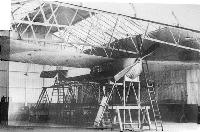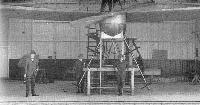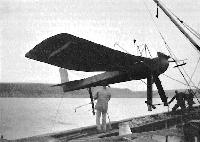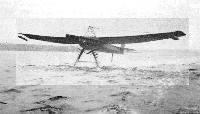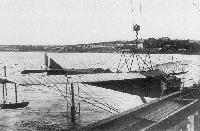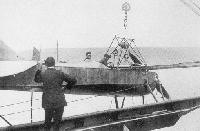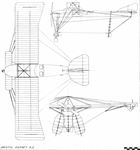C.Barnes Bristol Aircraft since 1910 (Putnam)
The Bristol-Burney Flying Boats
Coanda's biplane, No. 120, was not the first Bristol seaplane, for over a year earlier there had begun a very interesting series of experiments, which continued in a great secrecy almost up to the outbreak of war in 1914. In October 1911 Howard Pixton undertook a series of overwater flights from Hayling Island in a Boxkite (No. 29) fitted with flotation bags under the wings, with Lt. Charles Dennistoun Burney, R.N., son of Admiral Sir Cecil Burney, as his passenger. Lt. Burney was very enthusiastic about the possibility of operating naval aircraft with the Fleet independently of shore bases and had studied the pioneer work of Forlanini and Guidoni on the use of hydrofoils for lifting motor boats above rough water to reduce drag at high speeds. On his father's advice, he approached Sir George White privately with several ideas which he wished to patent jointly with the Company, so as to ensure their adequate exploitation.
Burney's specification for a naval aeroplane comprised the following novel features: a buoyant hull; hydrofoils for take-off from rough water; wings which could be folded for stowage of the aircraft on an ordinary boat deck and unfolded while taxying; separate air and water propellers, the latter to be driven for taxying by either one of two independent engines, both of which would be used together for flight. Further proposals envisaged inflatable wings and fuselage and 'means of varying the area of pneumatic planes by furling'. As all these very original ideas would require a great deal of research into materials and methods, he suggested, to start with, that the G.E.l biplane, No. 64, then being built, should be equipped with a water undercarriage consisting of three 'hydropeds' or legs carrying a cascade of hydrofoil vanes. Five torpedo-shaped pneumatic floats under the fuselage and wing would support the aircraft while at rest, but were not intended to act as running surfaces.
The Directors were interested in this project and, having been assured of Admiralty support, set up a secret design office, called 'X Department' to develop it. 'X Department' was entirely detached from the main drawing office at Filton House and began work just after Christmas 1911, consisting only of Frank Barnwell and one assistant, Clifford Tinson, who joined him in the first week of January 1912. Frank Barnwell, who had been apprenticed to the Fairfield Shipbuilding Company on Clydeside, had helped his elder brother Harold to build and fly the first successful Scottish aeroplane, which in 1911 had won the Law prize of ?50. After this success, the brothers carne south to Brooklands, where Harold joined Vickers as a test pilot, while Frank was on the point of going in with A. V. Roe when he received a much more exciting offer from Sir George White to take charge of the new secret design office at Filton.
Burney proposed to equip his first biplane, designated X.l, with a 60-80 h.p. E.N.V. engine driving both air and water propellers through clutches, with bevel gears and shafts running inside the hydroped legs. The countershaft carrying both clutches was to be mounted between the cylinder banks above the engine, which drove it through a chain. Barnwell examined Burney's scheme carefully and concluded that success would only be attained with a larger and cleaner design; he proposed a monoplane with a boat hull and buoyant wing-tips. Experiments were done on the stiffness of a long cylindrical pneumatic tube, and a wing was designed using eight such tubes side by side spanwise within lightweight ribs which maintained the aerofoil profile. But the rubber-proofed fabric, which was the only material then available, was too heavy when made up to the required strength and so the idea of a pneumatic wing was rejected.
Barnwell's layout for a monoplane flying boat with hydropeds was approved for construction and was designated X.2, having sequence No. 92. The hull was planked with thin mahogany veneer covered with sailcloth and varnished. The wings, of three-spar design, had warp control and were rigged at a pronounced dihedral angle; they were finished with a waterproof varnish to provide lateral buoyancy. Dual controls were installed in the cockpit amidships, and the engine, an 80 h.p. Canton-Unne watercooled radial was mounted in the nose, driving both air and water propellers through two Hele-Shaw clutches. The airscrew was a conventional two-bladed tractor, while the two water propellers were mounted at the lower ends of the two forward hydropeds.
On 9 May 1912, X.2 was put on board the lighter Sarah at Avonmouth and taken with great secrecy to Dale, on Milford Haven. Flotation tests were not at first satisfactory, but eventually the leaks were stopped and taxying trials began. Propelled by its water screws, the boat got away quickly, but after about 50 yd. the streamline fairings of the hydroped tubes were torn off by water friction. Static tests with the airscrew clutched-in showed some vibration in the front bearing carrying the primary chain drive from the crankshaft, and this had to be remedied. Towing tests behind a Naval torpedo boat were fairly satisfactory, but the craft was unstable at moderate speeds. Underwater stability was eventually obtained by reducing the area of some of the hydrofoils and adding water rudders and a controllable water elevator on the aft hydroped. Although these were adequate for towed stability, it was found impossible to prevent the craft heeling over when the water screws were clutched in, due to unequal torque reactions. It was necessary also to fit wingtip floats because of the yaw caused by the drag of whichever wing was in the water.
In September stronger streamline casings were fitted to the hydropeds, and it was decided to rely on towing for the preliminary air test. Tests under power had been delayed because the engine stalled when both water and air propellers were engaged, so the engine was removed and 500 lb. of ballast substituted for it.On 21 September 1912, X.2 was towed by the torpedo boat into a 12-knot wind, and at 30 knots airspeed rose clear of the water in a climbing attitude. Burney's colleague George Bentley Dacre was in the cockpit reading instruments, but the controls were preset for level flight and locked, so he had no means of correcting the nose-high attitude, but the aircraft would certainly have regained a level path if the towing party had not been too prompt in slipping the tow, with the result that the craft stalled, sideslipped and crashed, fortunately without injury to Dacre.
The Admiralty agreed to continue helping with man-power and dockyard facilities, but it was decided that X.2 was not worth a major repair, so in March 1913 a second flying boat, X.3, was put in hand at Filton, incorporating many improvements. This craft, No. 159, was larger than X.2 in both beam and wing area. The hull framework was made at Filton and sent to Cowes for Saunders to cover it with their Consuta sewn plywood, and the completed aircraft was shipped to Dale in the Sarah in August. One major change in X.3 was that the water screws were contra-rotating and mounted back-to-back, being driven by a single shaft running in a separate vertical tube located midway between the front hydropeds, so that the thrust-line was central and torque reaction was cancelled out. The wings were rigidly braced and lateral control was by inverse-tapered warping ailerons; only a single set of controls was installed in the side-by-side cockpit. At first it was proposed to power X.3 by two 70 h.p. Renault engines, but the Admiralty offered to lend a 200 h.p. Canton-Unne radial, and this was accepted. Preliminary taxying tests were done with an 80 h.p. Gnome, dummy outriggers being substituted for the wings to carry the wing-tip floats. The latter carried small hydrofoils, and the main hydropeds were fitted with controllable water rudders and a water elevator. Stability under tow was very good and taxying performance satisfactory, although the nose dipped when the airscrew was clutched in. To counteract this tendency, Barnwell devised a supplementary front elevator just aft of the airscrew, its control being co-ordinated with the clutch operation so as to lift the nose while the airscrew drive was being taken up. The wings and the 200 h.p. engine were then installed, and the aircraft was ready for flight testing by Busteed in June 1914, when it was urlfortunately grounded on a hidden sandbank, necessitating major repairs. The Company then asked the Admiralty for more substantial backing in order to continue the trials, but this was refused and, after a visit to Dale by Sir George White on 8 July 1914, the programme was discontinued and X.3 was brought back to Filton, where it remained in store until 1920, when it was scrapped.
Barnwell was well aware of the deficiences of bevel gears and long shafts, and in a letter to Stanley White in December 1913 he sketched out a much simpler hydrovane flying boat having chain-driven outboard airscrews powered by a central engine; the airscrews were arranged to swing up for taxying and take-off, and to a lower position giving an optimum thrust-line for flight; no water screws were necessary and all gearing and torque shafts were eliminated. Although not developed in 1914, this layout was briefly revived by Barnwell in 1921 in his Type 66 project, which featured retractable hydrovanes and a Napier Lion engine, but this was never built. So ended a series of experiments which, though unsuccessful so far as their primary objects were concerned, led to Burney's invention and development of the Paravane mine-sweeping device in 1915.
SPECIFICATION AND DATA
Type: Burney Flying Boats
Manufacturers: The British & Colonial Aeroplane Co. Ltd., Filton, Bristol
Model X1 X2 X3
Power Plant 60 hp E.N.V. 80 hp Canton-Unne 200 hp Canton-Unne
Span 34 ft 55 ft 9 in 57 ft 10 in
Length 30 ft 30 ft 8 in 36 ft 8 in
Wing Area 325 sq ft 480 sq ft 500 sq ft
Accommodation 2 2 2
Production nil 1 1
Sequence Nos. - 92 159
Показать полностью
G.Duval British Flying-Boats and Amphibians 1909-1952 (Putnam)
Burney X.1, X.2, and X.3 (1911-1913)
In the summer of 1911, Lieut. Charles Burney, r.n. (later Sir Charles Burney, of Airship R.100 fame) obtained Admiralty sanction for the British and Colonial Aeroplane Company to undertake design of a ship-borne aircraft employing hydrofoils to achieve take-off and landing on rough water. Burney had studied the works of the Italian pioneers Foriannini and Guidoni on the application of hydrofoils to improve the performance of fast motor boats, and was convinced that the hydrofoil had applications to the design of marine aircraft. Experiments began in the autumn of 1911, when Burney co-operated with Howard Pixton in a series of over-water flights from Hayling Island in a Bristol Boxkite equipped with flotation bags. In December, Frank Barnwell was appointed experimental designer for the project, taking up his duties in a private house at Filton which became known as ‘X’ Department, and was shrouded in secrecy.
X.1
In collaboration with Burney, Barnwell produced the first design study, known as the X.1 This was a modification of the Gordon England biplane (G.E.1). The original 50 h.p. Clerget engine was to be replaced by a more powerful eight-cylinder E.N.V., driving a shaft between the cylinder banks with a Hele-Shaw clutch at each end. The front clutch was to drive a normal tractor propeller, while the rear clutch drove a bevel gearbox from which two shafts extended downwards inside tubular undercarriage legs fitted with groups of hydrofoils. At the bottom of each leg there was a further bevel drive to a water propeller. A third strut, also equipped with hydrofoils, was fitted under the rear fuselage. These grouped hydrofoils were called ‘hydropeds’. The idea was that, when driven by the water propellers, the craft would rise out of the water on the hydropeds until there was sufficient clearance for the flight propeller to be clutched in, and take-off would then be made. While at rest on the water, the aircraft would have floated on five torpedo-shaped air bags, which were not, however, intended to act as planing surfaces.
In January 1912, Barnwell, now joined by an assistant, Clifford Tinson, proposed that the biplane arrangement should give way to a monoplane wing of startling ingenuity. This was to be pneumatic, formed of eight span-wise air bags arranged to fit into a suitable wing section and capable of inflation to high pressure. The aerofoil profile would be maintained by flat spruce strips, forming ribs, and hinged at leading and trailing edges, with bicycle spokes acting as tension members between the upper and lower strips. Externally braced, the wing was to be fitted with ailerons, also inflatable. Storage would be simplified by deflation of the entire wing structure. Unfortunately, the rubberised canvas of the day proved to be too weak and too heavy for the demands made upon it, and the idea had to be shelved.
X.2
In February 1912, a new design, the X.2, was produced, and construction commenced. In this, the flotation bags were eliminated, and the fuselage was built as a proper hull, planked with mahogany and covered with varnished sailcloth, a normal monoplane wing being fitted. This craft, Works No. 92, was built in the experimental shop at Filton, and equipped with side-by-side dual controls. The clutches and hydropeds developed for X.1 were used, but the engine was a water-cooled radial Canton-Unne of 80 h.p. On 9 May, 1912, X.2 was put aboard the lighter Sarah at Avonmouth, and taken to Dale, near Milford Haven. After overcoming initial leakages, taxying under power from the water screws was attempted, and later the craft was towed behind a torpedo boat. Despite modification, it proved impossible to prevent the machine from heeling over when the water screws were clutched in during towing. Eventually, in September 1912, it was decided to rely upon towing for the preliminary air tests. The engine was replaced by 500 lb of ballast, and on 21 September, X.2 was towed into a 30-knot wind with Lieut. G. Bentley Dacre, R.N., in the cockpit. At an airspeed of 42 knots, it rose clear of the water in a climbing attitude, but premature release by the towline party caused it to stall and crash, though without injury to Dacre.
X.3
The Admiralty agreed to continue the experiments, and work commenced on an improved design, the X.3. The engine fitted was a 200 h.p. Canton-Unne, and although similar to X.2 in most respects, this machine had wingtip floats with small hydrofoils under them. The hull frame, constructed at Filton, was then transported to Saunders at Cowes for covering with their patent ‘Consuta’ sewn plywood. To overcome torque reaction, the water screws were mounted back to back on a central pylon, so that they rotated in opposite directions. This machine, Works No. 159, was shipped to Dale in August 1913, and towing tests were very satisfactory. The nose dipped when the flight propeller was clutched in, - so to overcome this Barnwell designed an elevator, located in front of the mainplane and linked to the propeller clutch control. However, before the device could be fitted, X.3 came to grief while taxying, when it was wrecked on a sandbank.
With this mishap, the experiments came to an end, but the principle of the hydrofoil was employed by Burney in his invention of the paravane for minesweeping. In 1930, the Piaggio Pegna P.C.7 racing seaplane project utilised an almost identical layout to X.3, but also was a failure due to mechanical problems with the water screw.
SPECIFICATION
Power Plant:
X.1 (project) - 60 h.p. E.N.V. Vee-eight engine
X.2 - 80 h.p. Canton-Unne water-cooled radial engine
X.3 - 200 h.p. Canton-Unne engine
Span:
X.1 - 34 feet
X.2 - 55 feet 9 inches
X.3 - 57 feet 10 inches
Length:
X.1 - 30 feet
X.2 - 30 feet 8 inches
X.3 - 36 feet 8 inches
Wing Area:
X.1 - 325 square feet
X.2 - 480 square feet
X.3 - 500 square feet
Показать полностью
H.King Aeromarine Origins (Putnam)
Some truly remarkable experiments were conducted jointly by the British and Colonial Aeroplane Co (later the Bristol Aeroplane Co) and Lt C. D. Burney, R.N. Stimulated by work in Italy - especially that of Guidoni - Burney persuaded the company to undertake a secret design and development programme. The first design, the X.1, was for a biplane; but this was abandoned. The X.2 was a monoplane with a boat hull which, after various trials and modifications, succeeded in becoming airborne. Unhappily it crashed almost immediately, owing to the premature slipping of the tow from a Naval torpedo boat. The X.3 was larger and more refined, but never became airborne. In June 1914 it was taxied into a hidden sandbank and, following WIthdrawal of Admiralty support, the experiments were discontinued.
The essential features proposed by Burney are set out in a patent of 1911. A monoplane layout is shown and the craft is described as an 'aeronautical apparatus furnished with laterally extended wings and having a body of boat-like form provided with inclined hydropeds upon which are disposed hydroplanes...' Mention is made of propellers and rudders for use in water, situated at the lower ends of the hydropeds, the rudders being connected to the wing-warping controls and to the aerial rudder so as to operate simultaneously and in sympathy therewith. It is further stated: 'The propeller for propulsion in the air is situated at the forward end of the apparatus and is put into operation as soon as the lift produced by the combined action of the water propellers and the hydroplanes is sufficient to enable the aerial propeller to be used.'
Показать полностью
M.Goodall, A.Tagg British Aircraft before the Great War (Schiffer)
Deleted by request of (c)Schiffer Publishing
BRISTOL BURNEY hydroplanes
A series of three of these machines with buoyant hulls, buoyancy bags in the first case, and hydrofoils on legs for lifting the machine from the water, were built. The original biplane suggested by Lt. Burney RN was not constructed, as Barnwell had reservations and he proposed a larger monoplane, two versions of which were both built and tested. The design required the use of both air and water propellers.
BRISTOL BURNEY X.1 biplane
This was to be a two-seater biplane based on the GE.1 design, to which it was proposed to add five flotation bags below the wings and fuselage. Three hydroped legs carrying hydrofoils were immersed when the machine was at rest and two of these carried underwater propellers, driven from the single engine. The transfer of power from water to air propeller was effected by engaging and disengaging clutches on a countershaft mounted between the cylinder banks. The X.l was not built.
Power: 60hp ENV type F eight-cylinder water-cooled vee.
Data
Span 34ft
Area 325 sq ft
Length 30ft
BRISTOL BURNEY X.2 monoplane
This second design was built as a flying boat with a planked and sealed hull. It was a side-by-side two-seater monoplane with dual controls and wing warping for lateral control. A similar layout to that of the X.l, was used, with three hydropeds and hydrofoils and water propellers on the two front legs.
Trials were carried out at Dale in May 1912, but damage to the hydrofoils occurred during taxiing before the airscrew could be engaged. During later tests with both air and water propellers engaged the engine proved to be insufficiently powerful. On 21 September 1912, during towing tests with engine removed and equivalent ballast, the aircraft rose and sideslipped into the water and the resulting damage was not repaired.
Power: 80hp Salmson (Canton-Unne) seven-cylinder water-cooled radial.
Data
Span 55ft 9in
Area 480 sq ft
Length 30ft 8in
One aircraft built Works No.92.
BRISTOL BURNEY X.3 monoplane
A larger replacement for the X.2 was begun in May 1913. The hull framework was made at Filton, but was made lighter by being covered with 'Consuta' wire-sewn plywood, this work being carried out by SE Saunders Ltd. at Cowes. The lateral control was by ailerons. In addition to the hydrofoil legs a central mounting for contra-rotating water propellers was adopted to cancel out torque reaction and improve stability.
Initial trials in 1913 were carried out with an 80hp Gnome engine installed and with the wings replaced by a temporary structure with floats at the tips. The main hydropeds were fitted with both water rudders and elevators. An elevator just behind the airscrew was operated in conjunction with the clutch, when the airscrew was engaged.
The final aircraft was ready for testing by Harry Busteed in June 1914, but it grounded on a sandbank and was damaged. Further work was not approved and the machine was stored until 1920, when it was scrapped. One aircraft built Works No. 159.
Power: 200hp Salmson (Canton-Unne) 2.M.7 fourteen-cylinder water-cooled radial.
Data
Span 57ft 10in
Area 500 sq ft
Length 36ft 8in
Показать полностью
P.Lewis British Aircraft 1809-1914 (Putnam)
Bristol Burney X.1, X.2 and X.3
During October, 1911, following several over-water flights made from Hayling Island, Hants., with C. Howard Pixton in a Boxkite fitted with flotation bags beneath its lower wings' centre-section. Lt. Charles Dennistoun Burney, R.N., submitted proposals to the British and Colonial Aeroplane Company for the construction of an aircraft fitted with hydrofoils.
The idea arose from his investigations into the experiments made by the Italians Forlanini and Guidoni with a view to increasing the speed of fast motor-boats by enabling them to reduce water friction through planing on hydrofoils. The hydrofoil principle appeared to have great possibilities in assisting naval aircraft, in which the Admiralty was considerably interested, off the water quickly with their loads when at sea. The Admiralty agreed that the idea should be developed, and the firm set up a special design office for the purpose at 4 Fairlawn Avenue, Filton. The whole project was treated as highly secret, the section being designated X Department.
In December, 1911. Frank S. Barnwell was placed in charge as experimental designer and, working with Lt. Burney, prepared plans for a revised version of the Gordon England G.E.I biplane converted into a hydrofoil seaplane. In X. 1, as the project was known, the 50 h.p. Clerget engine was supplanted by the eight-cylinder 60 h.p. E.N.V. Type "F", which gave the extra power required. A shaft between the vee-form cylinder banks was fitted at each end with a Hele-Shaw clutch. A conventional tractor propeller was connected to the front clutch; the rear clutch was incorporated in a bevel gearbox. From this gearbox were taken a pair of shafts through downwards-extending tubes on the exteriors of which were fitted sets of superimposed hydrofoils. A second bevel gear at the lower end of each of these tubes was connected to a propeller which was submerged when the X.1 was in the water. A third hydrofoil-equipped tube, without any propeller, was mounted vertically under the after end of the fuselage, the name "hydropeds" being given to the tubes complete with their hydrofoils. Five airbags of streamline shape were intended to support the X.1 on the water, with the actual planing being performed by the hydrofoils. Initial movement in the water was to be provided by the engagement of the underwater propellers, with the flying propeller being engaged by its clutch once the X.1 had raised itself sufficiently out of the water upon its hydrofoils.
Before the X.1 could be built, Barnwell and his assistant designer Clifford W. Tinson, who had joined him in the project in January, 1912, had second thoughts about the entire scheme, and a radical new concept was put forward. The biplane lay-out was discarded and was replaced by that of a monoplane, again a tractor, whose wings, including the ailerons, were to be inflatable. The profile of the wing section was to be filled by eight rubberized-canvas airbags of different diameters, with their length running from tip to tip. The wing section was to be maintained by external flat spruce ribs, joined by bicycle spokes between the upper and lower booms with hinged joints at the leading and trailing edges. Normal external wire bracing was proposed and, besides providing buoyancy on the water and making fewer under-fuselage floats necessary, the wings could be deflated for stowage aboard ship. However, the inflatable wings feature was too far ahead of its time to be practical with the heavy and comparatively weak rubberized-canvas then available.
During the following month, in February, 1912, the project was revised completely once again under the designation X.2, works number 92. The fuselage was built as a waterproof hull, covered with thin mahogany, over which was varnished sailcloth, the intention being that this should rest in the water without the aid of separate floats. The engine used was the water-cooled 80 h.p. Canton-Unne, coupled to the clutch and hydropeds designed for the preceding X.1. The three struts carrying the hydrofoils were of streamlined section and the thrust-line of the flight propeller was set high in the fuselage for maximum clearance. The tailplane and elevators were mounted on the upper longerons and the vertical surfaces consisted of a rudder only. The wings were modified into a simpler conventional type with ribs built up around three spars, but were still designed to be buoyant; small, rectangular-section floats were attached later by short struts towards the wing-tips when it was found that the tips kept submerging owing to the lateral instability of the hydropeds. The cockpit was provided with side-by-side seats and dual controls.
In just over two months the X.2 was complete and ready for tests, which were to be conducted at Dale, near Milford Haven, it was taken there on board the lighter Sarah, loading being carried out at Avonmouth on 9th May, 1912. Some minor leaks were encountered when the machine was put into the water, but, after they had been attended to, attempts were made to taxi with the under-water propellers operating. Tests were made also by towing behind a naval torpedo-boat and, as a result of these practical experiments, alterations were made to the hydrofoil system to improve stability in the water. As a further aid to this, under-water rudders were fitted and a controllable water elevator was added to the hydroped at the rear. Despite these refinements, trouble was still experienced with the machine heeling over when the water propellers were clutched in under tow. Later in the year, in September, the decision was taken to commence the first air tests but still to rely upon towing. To ascertain the X.2's airborne characteristics the Canton-Unne was taken out, of the nose and 500 lbs. of ballast was inserted in its place.
Towing commenced on 21st September, 1912, with Lt. G. Bentley Dacre, R.N., in control of the aircraft. When a towing speed of 12 knots was reached the X.2 left the water in a steep climb and, before Lt. Dacre could level out, the line was released from the boat. The machine stalled immediately, and side-slipped into the water and was damaged, but Lt. Dacre was unhurt.
The project was still considered worthy of continuation, and the Admiralty sanctioned further work on it. A new version, designated X.3, with works number 159, was designed by Barnwell and Tinson. The machine was larger than the X.2, and consideration was at first given to powering it with a pair of Renault engines of 80 h.p. each. The Admiralty offered to lend a 200 h.p. Canton Unne, and it was then decided to take advantage of the greater power thus provided. After being constructed at Filton, the framework of the hull was sent to Cowes, Isle of Wight, where S. F. Saunders covered it with their Consula system of plywood sewn with copper wire. The X.3's wings were fitted with ailerons, and small hydrofoils were embodied under the floats at the wing-tips. An attempt to eliminate torque reaction from the water propellers was made by installing them back-to-back on a central pylon separate from the hydropeds, and rotating in opposite directions. The work took nearly a year to complete and the X.3 arrived at Dale in August, 1913, for the resumption of the experiments. Behaviour under power was found to be very good, apart from a tendency for the nose to dip when the flight propeller was engaged. Barnwell designed an elevator, to be controlled by the flight clutch and mounted in front of the wings, which it was hoped would eliminate the fault.
The modification was not given a chance to prove itself, as before it could be incorporated the X.3 was wrecked on a sandbank during taxying trials. Thereafter, as increased financial support from the Admiralty was not forthcoming, the hydrofoil project was dropped to enable full concentration of resources upon seaplanes of a more conventional type.
SPECIFICATION
Description: Two-seat tractor hydro-monoplane. Wooden structure, fabric covered.
Manufacturers: The British and Colonial Aeroplane Co. Ltd., Filton, Bristol.
Power Plant: (X.2) 80 h.p. Canton Unne. (X.3) 200 h.p. Canton Unne.
Dimensions: (X.2) Span, 55 ft. 9 ins. (X.3) Span, 57 ft. 10 ins. (X.2) Length, 30 ft. 8 ins. (X.3) Length, 36 ft. 8 ins. (X.2) Wing area, 480 sq. ft. (X.3) Wing area, 500 sq. ft.
Показать полностью



